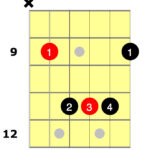The Jackson Rhoads Guitar. Just the name evokes images of shredding solos and revolutionary design. As an owner of an original Rhoads Tribute, a piece from the early Floyd Rose era, I can attest – it’s pure guitar perfection. The genius of the Rhoads design lies in its fusion of Flying V aggression and Les Paul sophistication. Yet, the story behind this iconic instrument is more nuanced than many realize, and owning a few of these axes has offered me a unique insight.
The guitar that sparked it all, Randy Rhoads’ “Original Sin,” while visually striking, was actually rejected by Rhoads himself. The design, in its initial form, suffered from limited upper fret access and a less-than-ideal pickup switch placement. Jackson listened, and the design evolved. The second iteration, believed to be named “Concord” after the supersonic jet, became the quintessential Rhoads shape. This “Concord” design led to what I consider the pinnacle of Rhoads guitars: the PCS, or “Player’s Choice Series.” I’m fortunate enough to have one of these in my collection as well.
Fueled by the demand for these early 1990s tributes, Jackson (now Fender/Jackson) has revisited these classic designs, releasing what they call “truer to spec” and “rarer” reproductions like the Mike Shannon editions of the Original Sin and Concord. However, to me, these feel more like marketing ploys than genuine tributes, especially when compared to the original tributes. Perhaps it’s the bias of owning and cherishing the older models, but the newer releases, including the current Black Rhoads Stringthrough, just don’t capture the magic of the originals. The original “PCS” model, to my eye, remains the truer and more aesthetically balanced version.
For those seeking the ultimate Jackson Rhoads experience, understanding the evolution of these guitars is key. The “Original Sin” design, with its wings extending deep into the neck joint, hindering access to the higher frets, highlights the initial design challenges. You can see how the wings root high into the neck, reaching the 17th fret, significantly obstructing access beyond.
The Les Paul influence is undeniable in these early models, evident in features like the block inlays, dual volume/tone controls, top-mounted switch, and even the back routing. This design DNA is particularly visible in the PCS model’s back route.
In contrast, the PCS design showcases a significant improvement in playability. Notice how the wings are set back, joining the neck after the 19th fret, offering vastly superior access to the upper register. This refinement is what elevates the PCS and Concord designs above the initial “Original Sin” concept.
Now, if you’re hunting for a truly exceptional and affordable Jackson Rhoads, let me share a secret: seek out an early 90s Jackson Professional series Rhoads. I regret trading mine, a decision made only to acquire the PCS and avoid owning “too many” black Rhoads guitars. These MIJ (Made in Japan) guitars often matched, and sometimes exceeded, the quality of their MIA (Made in America) counterparts. Jackson eventually had to reduce their quality to differentiate them, making these early 90s models a sweet spot.
How do you identify a top-tier Professional series Rhoads? Look for these telltale signs:
-
Ebony Fretboard: A hallmark of quality Jacksons, distinguishing them from lower-tier rosewood boards.
-
“Professional” Headstock Logo: An early indicator, featuring a blank black truss rod cover. Later models might say “Rhoads Pro” in white, but the earliest are highly sought after.
-
“Jackson” Branded Pickups: These graced the golden era of late 80s and early 90s Jacksons. Later models transitioned to unmarked Seymour Duncans and then to Seymour Duncan branded pickups.
-
Vintage Wooden Hard Case: The older, wooden hard case, rather than the plastic SKB case, is another sign of an early, high-quality model.
g~~_3.JPG)
In conclusion, the Jackson Rhoads guitar is more than just an instrument; it’s a legacy. From the initial “Original Sin” to the refined PCS and the value-packed Professional series, each model tells a part of the story. For players seeking a blend of iconic design, playability, and collectibility, exploring the early 90s Jackson Rhoads guitars, particularly the PCS tributes and Professional series, is a journey well worth taking.

